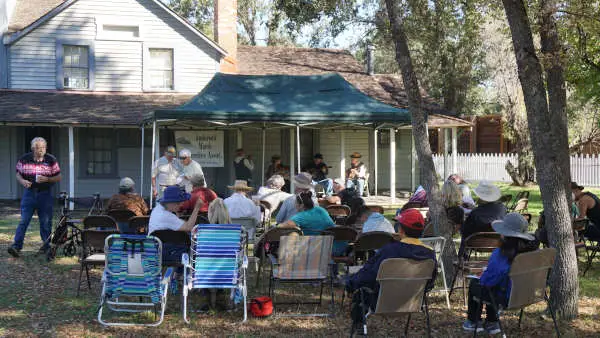
LOWER LAKE, Calif. — The history of Anderson Marsh State Historic Park and its latest milestone were celebrated on Saturday with music, memories and gratitude.
Gathered in the shade of the same ancient oaks clustered around the ranch house that retired California State Parks Ranger Tom Nixon said the Pomo once gathered acorns under, community members marked the park’s 40th anniversary.
Anderson Marsh Interpretive Association, or AMIA, hosted the event, which included a hike, educational and historic displays, and a great big anniversary cake. The group formed two years after the park’s creation and today has an active hand in running and supporting it.
The 1,605-acre park officially opened on Aug. 15, 1982. Its grounds encapsulate a layering of history and cultures. The park includes an area of unspoiled natural habitat filled with Indigenous cultural sites, and a time capsule of Lake County’s ranching families in the 19th and 20th centuries.
The park’s main building is the historic ranch house that was built in 1856 by the Grigsby brothers, who came from Tennessee on an ox cart, with additional phases of building continuing through 1923, when the Anderson family owned it.
There also are numerous outbuildings and barns, a windmill, and many hiking trails that take visitors out through a rich and varied landscape complete with all manner of wildlife — fish, birds, otters, muskrats, deer, mountain lion and bears.
Rita Durgin, a representative from Assemblywoman Cecilia Aguiar-Curry’s office, presented a resolution from Aguiar-Curry and Senate Majority Leader Mike McGuire commending the park on its anniversary.

The resolution noted that the park was created to protect 27 Native American archaeological sites, including those of the Koi Nation, and other cultural artifacts that date back as far as 14,000 years.
The park also holds “one of the oldest and most complete records of Native American cultural history in the California State Parks system,” the resolution stated.
The resolution also noted that the 540 acre portion of the park known as the Anderson Marsh Natural Preserve “constitutes one of the sole remaining natural wetland tule marshes in the County, protecting multiple native habitats for many species of birds like the Great Blue Heron and other wildlife.”
The park’s creation and continued operation are testament to the power of community — when people have ideas, the willingness to follow through on them, attentive lawmakers and the support of their neighbors.
Since its inception in 1980, its creation in 1982 and up to the present day, Anderson Marsh has been the little park that could.
It has endured numerous challenges, from early opposition from the property owners, to a state bureaucracy that wasn’t initially interested in the park plan, a building project contractor who was caught digging up artifacts and arrested, and staffing and budget cuts in the 1990s.
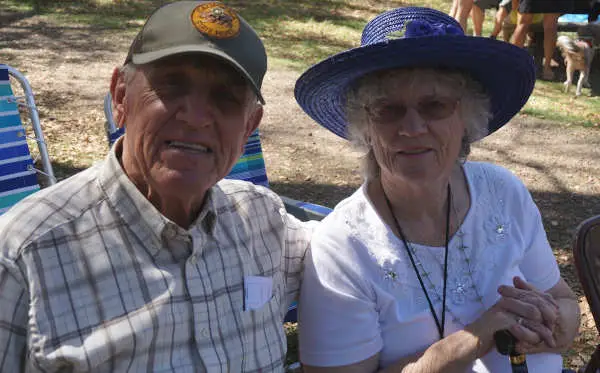
In 2008, then-Gov. Arnold Schwarzeneggar proposed to shutter dozens of state parks to address budget shortfalls. That year, his list included Anderson Marsh and Clear Lake State Park. Another proposal in 2009 also listed Anderson Marsh. Schwarzeneggar eventually relented and withdrew the proposal.
In 2016 the Clayton fire came close to destroying the park’s buildings, reaching the park entrance and causing park staff to evacuate the contents of the ranch house.
Then the COVID-19 pandemic hit, and caused some of the park’s favorite events, such as its Christmas celebration, to be canceled.
However, the park, which continues to be championed by a devoted group of volunteers and supporters, has survived and thrived.
In 2021, AMIA received a grant from the Department of Parks and Recreation in restoring and rehabilitating the three-acre entrance meadow that burned in the 2016 Clayton fire.
Other projects are underway, with HistoriCorps volunteers to paint a portion of the ranch house and repair windows, and stabilize and paint the outbuildings later this month.
In June, the city of Clearlake committed $21,000 to plant 100 valley oak trees at the park this fall.
In the spring, AMIA will launch its new twice-monthly “senior days” events, which include free bus trips, educational programs and lunch at the park, funded by a $9,220 “Parks Improvement” grant from California State Parks Foundation.
“This is a beautiful, beautiful place,” said Chris Glenn, the supervising ranger for both Anderson Marsh and Clear Lake State Park.

A vibrant history
During the Saturday celebration, the South Barn was opened so visitors could see exhibits,
Gae Henry, one of the park’s stalwart volunteers, shared the history of the native peoples and showed displays of taxidermy — from bobcats to owls to herons — that have made their home on the property.
Henry showed stone replicas of petroglyphs found on the property as well as some artifacts, including stone points and round sling stones.
She has an encyclopedic knowledge of the property, explaining that the South Barn’s original roof collapsed in a 1948 snowstorm, with the roof later being rebuilt with the original wood.
Henry said the teenage Grisgby brothers came to the property in 1855, riding in an ox cart from Tennessee.
They began construction of the original portion of the ranch house, and lived on the property for 15 years, Henry said.
During those years, a huge flood put Sacramento under 16 feet of water. The dam on Cache Creek was blamed, and vigilantes burned the mill and took down the dam.
“It didn’t help,” as it wasn’t about the dam, Henry said.
The Grigsbys sold the land to the Clear Lake Water Works Co. In 1885 John and Sarah Anderson — who Henry said traveled from Edinburgh, Scotland — purchased 1,300 acres the Grigsbys had owned from the water company.
The family had six children. Mora Anderson, the youngest, lived on the property until her death in 1966.
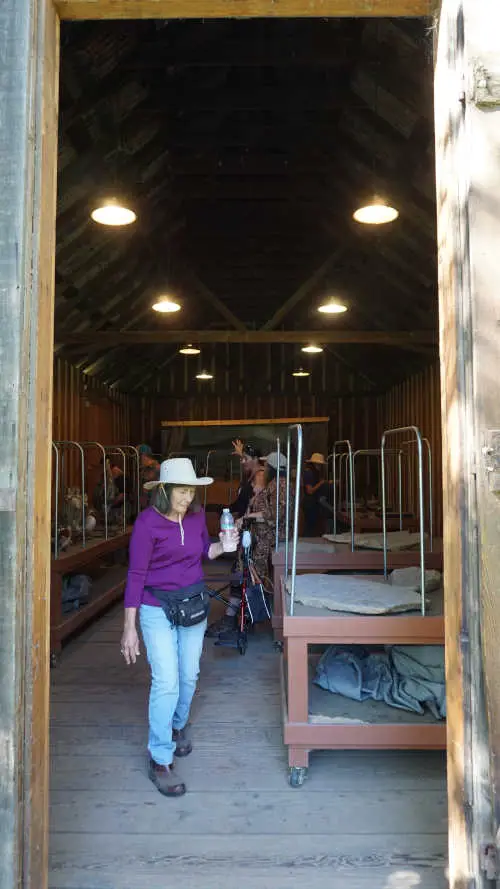
The fight to preserve the past
In 1980, when archaeologist John Parker began lobbying local and state leaders to create the park and protect its extensive Indigenous cultural sites, it wasn’t on any state list of properties planned for a park, according to former parks area manager, William Beat, who was on hand for Saturday’s celebration.
Beat said he didn’t think many people understood how much work went into getting the property in the first place.
The owners of the property that became the park were not initially willing to sell it to the state, Beat said. One of those owners, Ray Lyon, had planned an extensive development there that was to include condominiums, and he went to the Board of Supervisors to ask for the necessary zoning change.
The community rallied against the plan, and Beat said when Lyon’s attorney drove by and saw the parking lot for the meeting filled with cars, Lyons decided to go back and renegotiate with the state.
One of the people Parker enlisted to help with rallying the community to form the park was Roberta Lyons, who grew up with members of the Anderson family. At the time, Lyons was a reporter for the Clear Lake Observer American, which her family, the Hanchetts, owned at the time.
She wrote the first and most important stories about the effort to create the park. Today, Lyons is the AMIA president and one of the county’s greatest environmentalists, according to Nixon.
“The people make it happen,” Lyons said of the effort.
When the state finally agreed to create the park, Beat said he received a budget that he recalled as being up to $750,000 to cover park acquisition, renovation of the buildings and staffing.
Nixon and his wife, Valerie, both retired as rangers, worked in Lake County. He said propagating some of the younger oak trees at the park’s entrance are among his proudest accomplishments, and said they came from a time when rangers had more latitude for such projects.
“When it’s all said and done, it all comes down to the people in your life,” he said, crediting Parker for his efforts.
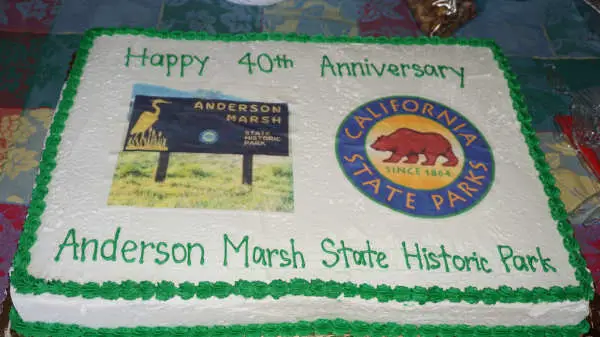
Nixon said Beat also had tried to get Indian Island to add to the park, an effort that didn’t succeed. However, Beat’s efforts to save the state’s redwoods in parks in other parts of the state did.
“He is a legend,” Nixon said.
Nixon recognized local Pomo leaders, including the late Nelson Hopper, and the Brown and Beltran families for their work and for sharing their knowledge and culture.
Others critical to the park’s creation and preservation include AMIA Board members Henry Bornstein and Gae Henry; Nixon said he didn’t know where the park would be without them.
“This place just got under my skin,” but in a very good way, Nixon said.
Beat also told Lake County News that Anderson Marsh has always been a special place for him.
Members of the Anderson family remain involved in the park today.
Gordon Haggitt, one of the descendants who retired in 2021 as the county of Lake’s longtime surveyor, today is a member of the AMIA Board.
Both he and his cousin, Winifred “Winnie” Anderson Lea — who came with her daughter and son-in-law — remembered herding cattle on the ranch with their great aunts and uncles.
Speaking of those who worked to make the property a state park, Haggitt said, “We’ve got an extra sense of gratitude.”
Email Elizabeth Larson at This email address is being protected from spambots. You need JavaScript enabled to view it.. Follow her on Twitter, @ERLarson, or Lake County News, @LakeCoNews.
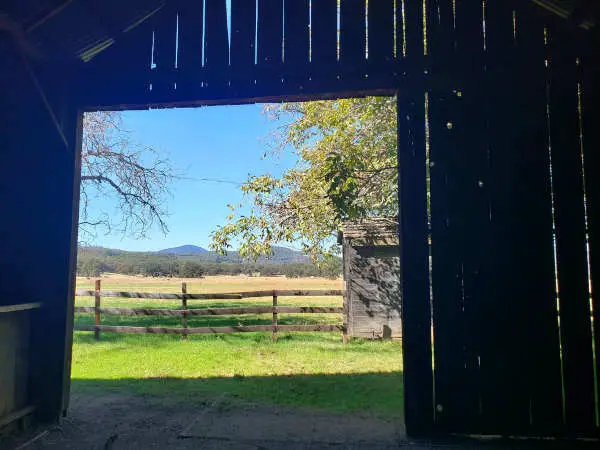

 How to resolve AdBlock issue?
How to resolve AdBlock issue? 





